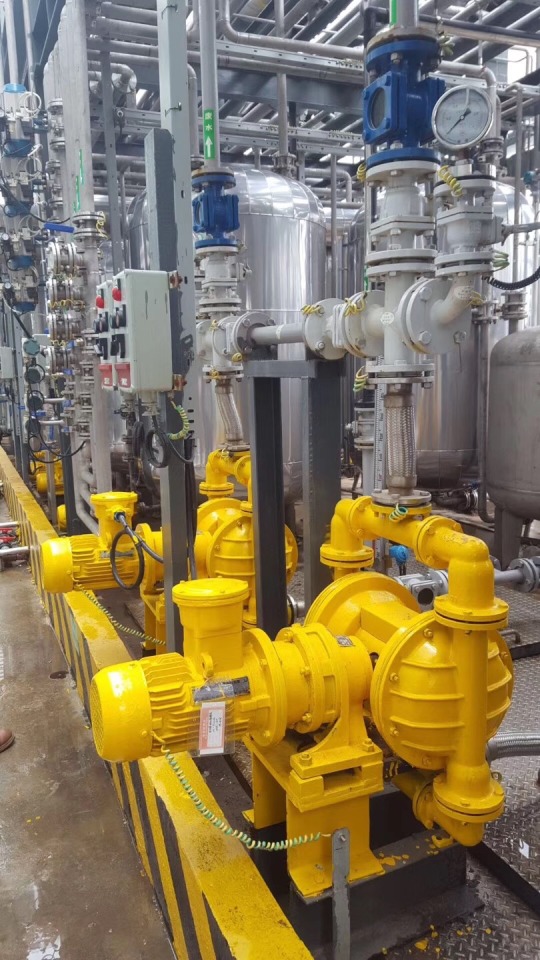Text
When to Use a Diaphragm Pump
Diaphragm Pumps Diaphragm pumps use the reciprocating action of a flexible diaphragm to move the liquid into and out of the pumping chamber. As the diaphragm flexes, it creates a vacuum at the inlet of the chamber that draws liquid into the chamber. The action of the diaphragm flexing in the opposite direction causes a decrease in the volume of the pumping chamber to occur and forces the fluid out of the discharge port.
Most industrial applications for diaphragm pumps use an engine and driveshaft to turn an offset connecting rod that raises and lowers the diaphragm. Raising the diaphragm opens the inlet valve, seals the outlet valve, expands the chamber, and allows liquid and air to enter the pump. Lowering the diaphragm causes pressure to seal the inlet check valve, open the outlet check valve, and allows the pump to purge liquid and air.
Diaphragm Pump Applications The construction industry relies on diaphragm pumps to remove slurry water from shallow depths and to solve slow seepage conditions that occur when groundwater seeps slowly into an excavation in areas that have high water tables. Because diaphragm pumps can move liquid with a 25% solid content, construction and farm applications may use the pumps for pumping sewage, cleaning septic tanks, and transferring liquid manure.
Selecting a diaphragm pump involves knowing the conditions presented by a specific application. Those conditions are: The type and composition of the liquid; The viscosity of the liquid; The desired flow rate; The potential pressure conditions on the inlet and outlet of the pump; The temperature of the liquid. Diaphragm pumps can lift almost any type of liquid including water, gear oils, acid, adhesive, and resins. Higher viscosity liquids may cause the pump to have a slower stroke. Because the type of diaphragm material may vary, matching the application with the pump also requires consideration of the impact of some chemicals on the diaphragm materials.
0 notes
Text
HOW TO USE A PNEUMATIC DIAPHRAGM PUMP?
When operating with a pneumatic diaphragm pump, pay attention to the following points:
1. Ensure that the maximum particles contained in the fluid do not exceed the maximum safety of the pump through the particle diameter standard.
2. The inlet pressure should not exceed the pump's maximum allowable operating pressure. Compressed air above the rated pressure may result in personal injury and property damage and damage to the pump's performance.
3, Ensure the pump pressure of the pipeline system can withstand the maximum output pressure achieved to ensure the clean and normal operating conditions of the drive gas system.
4. Electrostatic sparks may cause personal injury or death and property damage due to an explosion. Use a wire with a sufficiently large cross-section as required to properly and reliably ground the grounding screw on the pump.
5, Grounding requirements in line with local laws and regulations and the site requirements of some special requirements.
6. Fasten the pump and each connecting pipe joint to prevent electrostatic sparking due to vibration and shock. Use anti-static hoses.
7. To periodically check and test the reliability of the grounding system, it is required that the grounding resistance is less than 100 ohms.
8, To maintain good exhaust and ventilation, away from flammable and heat sources.
9. The exhaust of the pump may contain solid objects. Do not place the exhaust port facing the work area or people to avoid personal injury.
10. When the diaphragm fails, the conveyed material will be ejected from the exhaust muffler.
11. When transporting flammable and toxic fluids, please take the outlet to a safe place away from the work area.
12, Please use at least 3/8 "inner diameter inner wall smooth pipe connection exhaust and muffler.
13. The high pressure of the fluid may cause serious personal injury and property loss. Please do not pump or feed the pump when it is pressurized. The tube system carries out any maintenance work. If maintenance is to be performed, the air intake of the pump is cut off, the bypass pressure relief mechanism is opened to relieve the pressure in the piping system, and the connected pipe joints are slowly loosened.
14, Such as the transmission of the harmful toxic fluid pump, please do not send the pump directly to the manufacturer for repair. Properly dispose of it in accordance with local laws and regulations and use the genuine accessories of Shanghai Wangquan Pump Co., Ltd. to ensure its service life.
15, The use of liquid transport part of the aluminum alloy pump, do not use to transport Fe3 +-containing liquids and halogenated hydrocarbons and other halogenated hydrocarbon solvents, it will cause corrosion pump burst.
16. Ensure that all components that come in contact with the transport body are not corroded by the fluid being transported.
17. Ensure that all operators are familiar with the operation and master the safe use of the pump, if necessary, Assign necessary protective equipment.
0 notes
Photo

QIWEI PUMP-DBY3 EODD PUMP
Learn more>>> www.chinadiaphragmpump.com/
0 notes
Photo

QIWEI PUMP- QBYK3 Aodd pump
Learn more >>>> www.chinadiaphragmpump.com
0 notes
Photo

Welcome to contact us to learn more!
>>>>>[email protected]
#pump #pumps #industrialpump #diaphragmpump #aoddpump
0 notes
Photo

#Manufacturer of #Diaphragmpump
Qiwei industrial pump factory produces Diaphragm Pump with high quality and very competitive price for 20 years in China.
Welcome to contact us!
www.chinadiaphragmpump.com
1 note
·
View note


